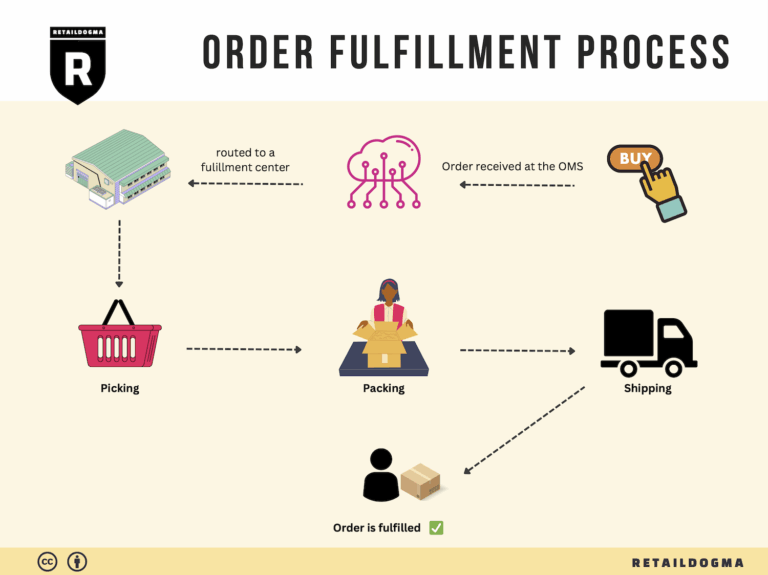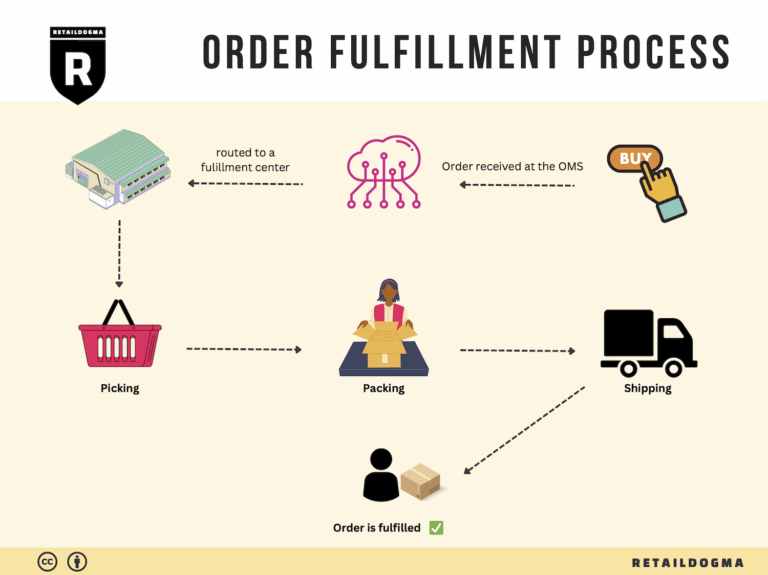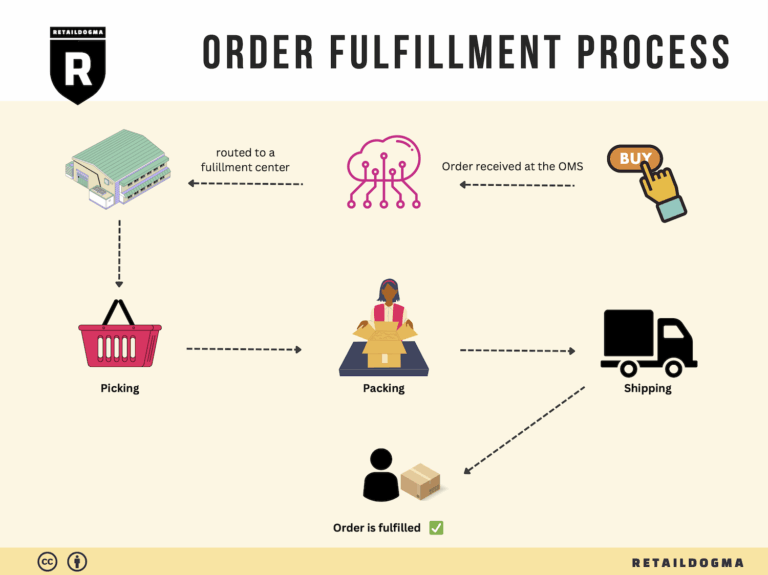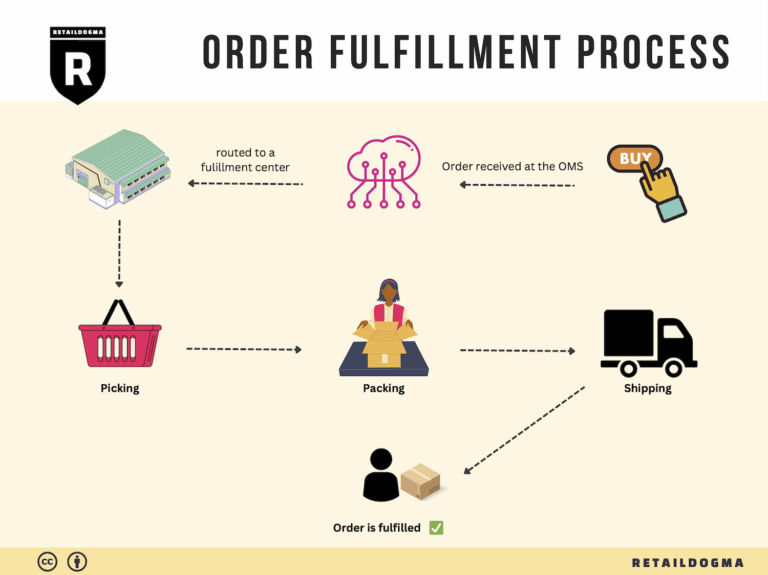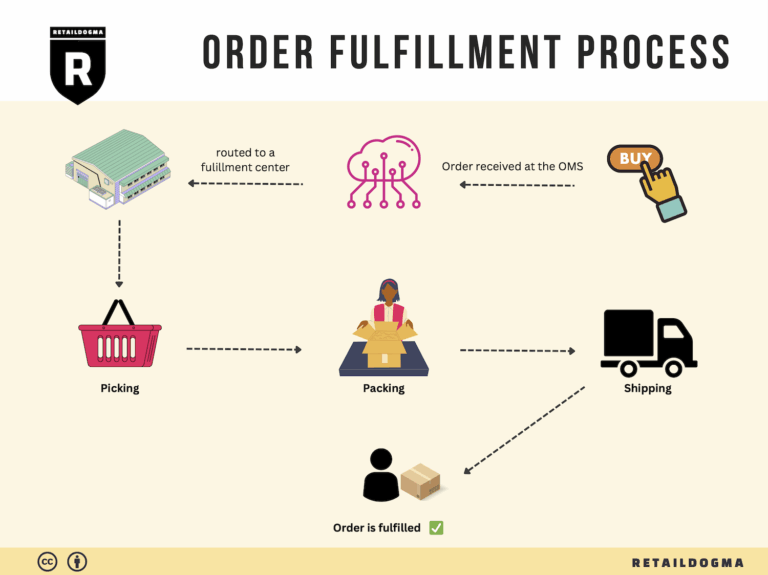What Is A Fulfillment Center? A Complete Guide (2025)
What is E-commerce Fulfillment? An Introduction for Growing Businesses
Understanding E-commerce Fulfillment: A Path to Efficiency
As an e-commerce business owner, you likely face the daunting challenge of managing the packing and shipping of your orders. This crucial aspect of your operations can quickly become overwhelming, especially as sales begin to scale. The process of fulfillment—the journey of getting a product from your warehouse to your customer’s doorstep—can be complex and time-consuming. However, understanding and optimizing this process is vital for sustaining growth and enhancing customer satisfaction.
Fulfillment encompasses all the steps involved in processing an order, from receiving and storing inventory to picking, packing, and shipping products. For growing businesses, effective fulfillment is not just about speed; it’s also about accuracy, cost-efficiency, and scalability. An optimized fulfillment process can lead to faster delivery times, reduced operational costs, and improved customer experiences, all of which are essential in today’s competitive e-commerce landscape.
This guide will explore various fulfillment models available to online businesses, including Third-Party Logistics (3PL) and Fulfillment by Amazon (FBA). Each model has its own set of advantages and challenges, and understanding these differences will help you choose the best fit for your operations. Additionally, we will cover the core services offered by fulfillment partners, such as inventory management, order processing, shipping solutions, and returns handling.
Selecting the right fulfillment partner is a critical decision that can significantly impact your business. This guide will provide practical tips on how to evaluate potential partners, including what to look for in terms of reliability, technology, scalability, and customer service. We will also discuss pricing structures and how to budget for fulfillment expenses, ensuring you can make informed financial decisions.
Ultimately, the goal of this guide is to empower you with the knowledge and insights necessary to navigate the complexities of e-commerce fulfillment. By making informed choices about your logistics strategy, you can streamline operations, enhance customer satisfaction, and position your business for sustainable growth. Whether you are just starting out or looking to scale your existing operations, effective fulfillment is the cornerstone of e-commerce success.
What You’ll Learn In This Guide
- What is E-commerce Fulfillment? An Introduction for Growing Businesses
- The Order Fulfillment Process: From ‘Buy’ Button to Customer’s Door
- Comparing Fulfillment Models: In-House vs. 3PL vs. Dropshipping
- A Deep Dive into Amazon FBA: Pros, Cons, and Who It’s For
- Core Services Offered by Fulfillment Centers
- How to Choose a Fulfillment Partner: A 6-Point Checklist
- Understanding Fulfillment Pricing: A Breakdown of Common Fees
- Frequently Asked Questions (FAQs) about Fulfillment
- Conclusion: Is Outsourcing Fulfillment the Right Move for Your Business?
- Important Disclaimer
The Order Fulfillment Process: From ‘Buy’ Button to Customer’s Door
1. Receiving Inventory
The order fulfillment process begins with receiving inventory, which is a critical step in ensuring that your e-commerce business can meet customer demand. When new stock arrives at your warehouse or fulfillment center, it is essential to verify that the shipment matches your purchase order. This includes checking quantities, inspecting for damages, and confirming that the correct products have been received.
Importance: Proper receiving processes help prevent stock discrepancies and ensure that your inventory records are accurate. Accurate inventory management reduces the risk of stockouts and overstock situations, which can lead to lost sales or increased holding costs.
Key Term: SKU (Stock Keeping Unit) – A unique identifier assigned to each product, which helps track inventory levels and manage stock efficiently.
2. Warehouse Storage
Once inventory is received and verified, the next step is warehouse storage. This involves organizing products in a way that maximizes space and facilitates easy access for order picking. Efficient storage systems, such as shelving, bins, and pallets, should be employed to categorize items based on factors like size, weight, and sales velocity.
Importance: Effective warehouse storage is vital for optimizing order fulfillment times. A well-organized warehouse reduces the time spent locating items, leading to faster processing of orders. Additionally, it helps maintain a clean and safe working environment.
Key Term: FIFO (First In, First Out) – An inventory management method where the oldest stock is sold first, minimizing the risk of product obsolescence and spoilage.
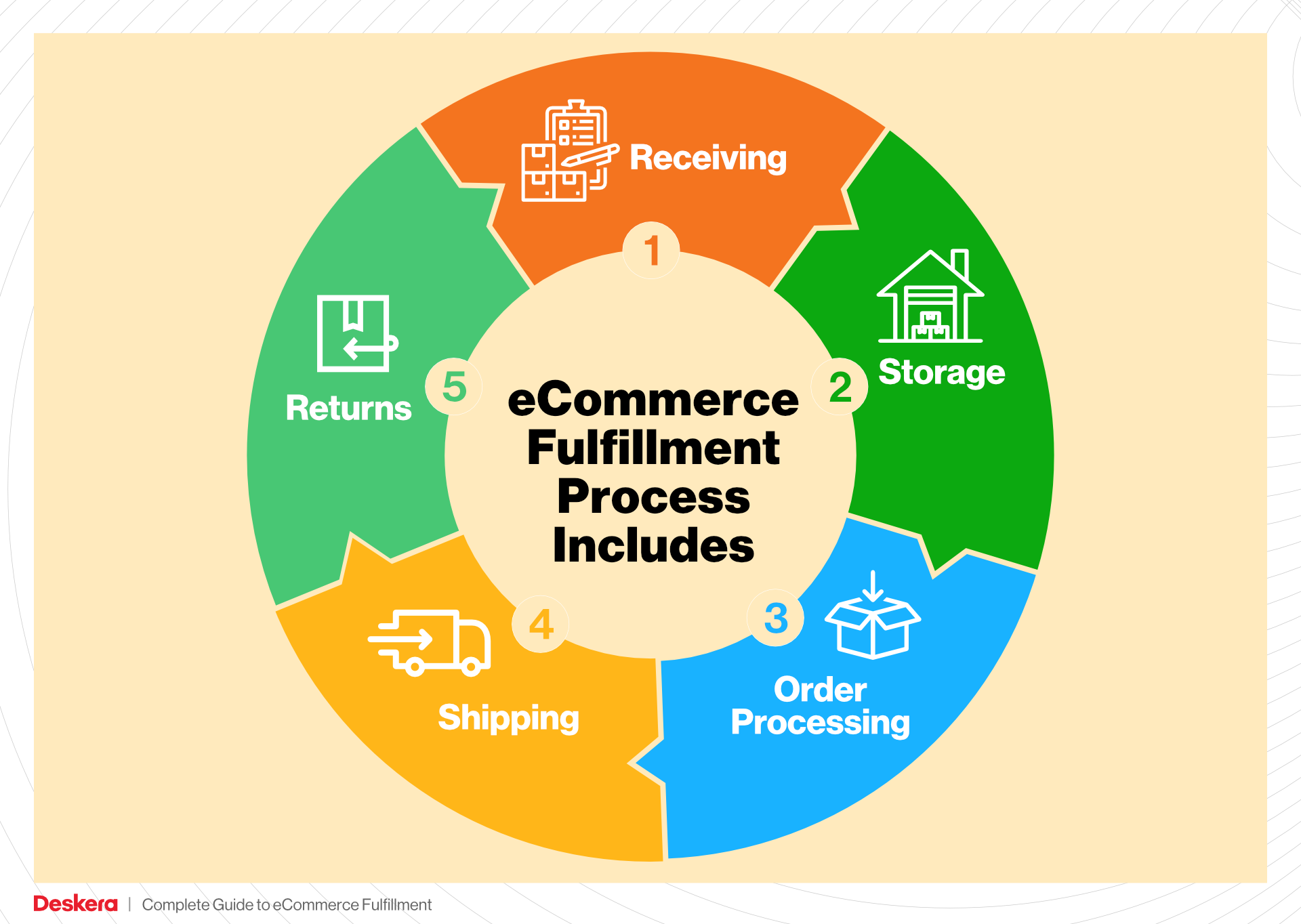
3. Order Picking
Order picking is the process of selecting the items that customers have ordered. This step typically involves using a pick list, which is a document that outlines the items and quantities needed for each order. Employees or automated systems then gather these items from the warehouse shelves.
Importance: Accurate order picking is crucial for customer satisfaction, as errors can lead to incorrect shipments and returns. Streamlining the picking process through efficient methods, such as batch picking or zone picking, can significantly reduce processing times and labor costs.
Key Term: Pick List – A document or digital tool that provides details of the items to be collected for an order, including their location within the warehouse.
4. Order Packing
After picking, the next step is order packing. This involves securely packaging the selected items to ensure they arrive at the customer’s location in perfect condition. It is important to choose the right materials, such as boxes, bubble wrap, or packing peanuts, to protect the products during transit.
Importance: Proper packing not only safeguards the products but also enhances the unboxing experience for customers. This step is also where shipping labels are generated and affixed to the packages, which is essential for tracking and delivery purposes.
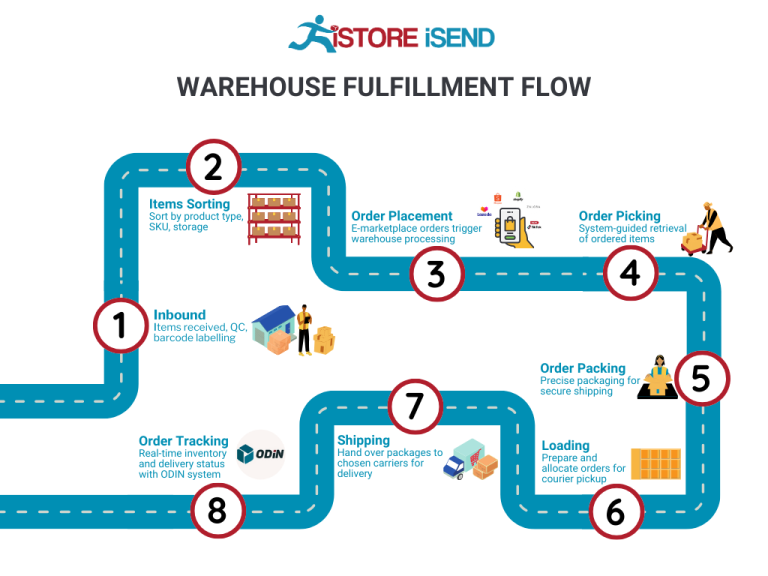
Key Term: Packaging Slip – A document included in the package that lists the items included in the order, providing transparency and helping customers verify their purchases.
5. Shipping & Delivery
The final step in the order fulfillment process is shipping and delivery. Once the order is packed, it is handed over to a carrier (such as UPS, FedEx, or USPS) for transportation to the customer’s address. It is essential to choose the appropriate shipping method based on factors like delivery speed, cost, and the customer’s preferences.
Importance: Timely delivery is a key component of customer satisfaction. Providing customers with tracking information enhances their experience by allowing them to monitor their package’s journey. Additionally, optimizing shipping costs can positively impact your profit margins.
Key Term: Last-Mile Delivery – The final step of the shipping process, where the package is delivered from a transportation hub to the final destination, often representing a significant portion of total shipping costs.
By understanding and optimizing each step of the order fulfillment process, e-commerce businesses can enhance efficiency, reduce costs, and ultimately improve customer satisfaction. Implementing best practices and leveraging technology in these areas will help scale your operations effectively.
Comparing Fulfillment Models: In-House vs. 3PL vs. Dropshipping
Fulfillment Model Comparison Table
| Model | Who Handles Inventory | Best For (Business Stage) | Key Advantage | Key Disadvantage |
|---|---|---|---|---|
| In-House Fulfillment | The business itself | Established businesses | Greater control over inventory and processes | High overhead costs and staffing needs |
| Third-Party Logistics (3PL) | A third-party provider | Growing businesses | Scalability and reduced operational burden | Less control over the fulfillment process |
| Dropshipping | Supplier or manufacturer | Startups or low-capital businesses | Low upfront investment and no inventory risk | Lower profit margins and potential quality issues |
In-House Fulfillment
In-house fulfillment refers to a model where the e-commerce business manages all aspects of warehousing, inventory management, and order processing internally. This model is typically adopted by established businesses that have the resources and capacity to handle logistics in-house. One of the primary advantages of in-house fulfillment is the level of control it offers over inventory, order accuracy, and customer experience. Businesses can tailor their processes to meet specific customer needs, ensuring that branding, packaging, and delivery are consistent with their overall strategy. However, the key disadvantage is the high overhead costs associated with staffing, warehousing, and maintaining inventory. As a business scales, these costs can become significant, making it challenging to remain agile and competitive in the market.
Third-Party Logistics (3PL)
Third-party logistics (3PL) is a fulfillment model where businesses outsource their logistics operations to specialized third-party providers. This model is best suited for growing businesses looking to scale without the complexities of managing logistics internally. The primary advantage of 3PL is scalability; as demand increases, businesses can easily adjust their logistics needs without the burden of hiring additional staff or investing in more warehouse space. Additionally, 3PL providers often have established networks, allowing for faster shipping times and potentially lower shipping costs. However, a significant disadvantage is the loss of control over the fulfillment process. Businesses must rely on their 3PL partner to maintain quality and accuracy, which can lead to discrepancies if not managed properly. Establishing clear communication and performance metrics is crucial to mitigate these risks.
Dropshipping
Dropshipping is a fulfillment model where the retailer does not keep products in stock but instead transfers customer orders directly to a supplier or manufacturer, who then ships the products to the customer. This model is particularly advantageous for startups or businesses with limited capital, as it requires minimal upfront investment and eliminates the need for inventory management. Retailers can offer a wide range of products without the risk of unsold inventory, making it an attractive option for new entrepreneurs. However, dropshipping also comes with its challenges. Profit margins can be lower compared to other models, as suppliers typically charge a fee for their services. Additionally, the retailer has limited control over product quality and shipping times, which can affect customer satisfaction. It is essential for businesses to carefully select reliable suppliers and maintain open lines of communication to ensure a positive customer experience.
Conclusion
Choosing the right fulfillment model is crucial for e-commerce businesses aiming to scale effectively. Each model—In-House Fulfillment, Third-Party Logistics (3PL), and Dropshipping—comes with its own set of advantages and disadvantages. In-house fulfillment provides control but at a higher cost, 3PL offers scalability with some loss of control, and dropshipping minimizes risk but may result in lower margins. Business owners must evaluate their specific needs, growth objectives, and available resources to select the fulfillment strategy that aligns best with their operational goals and customer expectations.
A Deep Dive into Amazon FBA: Pros, Cons, and Who It’s For
What is Fulfillment by Amazon (FBA)?
Fulfillment by Amazon (FBA) is a service provided by Amazon that allows e-commerce businesses to store their products in Amazon’s fulfillment centers. When a customer places an order, Amazon takes care of storage, packaging, and shipping the products directly to the customer. This service also includes handling customer service and returns, allowing sellers to focus on other aspects of their business.
With FBA, sellers can leverage Amazon’s vast logistics network, providing them with the ability to reach millions of potential customers while benefiting from Amazon’s trusted brand and customer service.
How FBA Works
-
Setup: To start using FBA, sellers create an Amazon seller account and register for FBA. They then prepare their products according to Amazon’s guidelines, which include proper labeling and packaging.
-
Shipping to Amazon: Sellers send their inventory to Amazon’s fulfillment centers. They can choose to ship their products in bulk or individually, depending on their business model.
-
Storage: Once Amazon receives the inventory, it is stored in their warehouses. Sellers can monitor their inventory levels through the Amazon Seller Central dashboard.
-
Order Processing: When a customer places an order, Amazon picks, packs, and ships the product on behalf of the seller.
-
Customer Service: Amazon handles all customer inquiries and returns, providing support to ensure customer satisfaction.
-
Payment: After the sale, Amazon deposits the proceeds into the seller’s account, minus the FBA fees.
Pros of FBA
1. Prime Eligibility
One of the most significant advantages of using FBA is that products become eligible for Amazon Prime. This means that Prime members can receive their orders with free two-day shipping, making your products more appealing to a vast audience of loyal Amazon customers.
2. Customer Trust
Amazon is a well-established and trusted brand. By using FBA, sellers can benefit from this trust, as customers often feel more secure purchasing items that are fulfilled by Amazon. This can lead to higher conversion rates and increased sales.
3. Multi-Channel Fulfillment
FBA is not limited to just Amazon sales. Sellers can use FBA to fulfill orders from their own websites or other marketplaces, making it a versatile solution for multi-channel selling. This can streamline operations and ensure consistent service across different sales platforms.
4. Simplified Logistics
FBA simplifies logistics for sellers. Amazon takes care of storage, packing, and shipping, allowing sellers to focus on sourcing and marketing their products rather than managing the complexities of fulfillment.
5. Scalability
As businesses grow, so do their fulfillment needs. FBA allows sellers to scale their operations without needing to invest in their own warehouse space or logistics infrastructure. This means they can handle increased order volumes more efficiently.
Cons of FBA
1. High Fees
While FBA offers numerous benefits, the costs can add up. Sellers incur various fees, including storage fees, fulfillment fees, and additional costs for returns or long-term storage. These fees can significantly impact profit margins, especially for low-cost items.
2. Strict Inventory Rules
Amazon has strict guidelines regarding inventory management. Sellers must adhere to these rules, including proper labeling and packaging, or risk penalties. Additionally, sellers can face issues with inventory limits, which can hinder their ability to stock enough products to meet demand.
3. Commingling Risks
FBA uses a commingling model where inventory from different sellers is stored together. While this can streamline operations, it poses risks. If a customer receives a damaged or defective item from another seller, it can negatively impact your seller rating, even if the issue was not yours.
4. Limited Control Over Shipping
Sellers relinquish control over the shipping process when using FBA. This means they cannot customize packaging or shipping methods, which may not align with their brand identity or customer expectations.
5. Complex Returns Process
While Amazon handles returns, the process can sometimes be complicated for sellers. Returns are processed according to Amazon’s policies, which may not always favor the seller’s interests, particularly for items that are damaged or missing.
Who is FBA Best For?
Fulfillment by Amazon is particularly well-suited for:
-
Small to Medium-Sized Businesses: Companies looking to scale their operations without investing heavily in logistics infrastructure can benefit greatly from FBA’s services.
-
New Sellers: Those new to e-commerce can take advantage of Amazon’s established platform and customer trust, making it easier to gain traction in a competitive market.
-
Businesses with High Inventory Turnover: Sellers with products that sell quickly can leverage FBA to fulfill orders efficiently while minimizing storage costs.
-
Brands Seeking Prime Eligibility: Companies that want to tap into Amazon’s vast customer base and offer Prime shipping will find FBA essential for increasing visibility and sales.
-
Multi-Channel Sellers: Businesses that sell across various platforms can streamline their fulfillment process by using FBA, allowing them to manage orders from multiple channels effectively.
In conclusion, while Fulfillment by Amazon offers numerous advantages that can help scale e-commerce operations, it is essential for sellers to weigh these benefits against the potential downsides. Understanding the implications of using FBA can help businesses make informed decisions and optimize their fulfillment strategies.
Core Services Offered by Fulfillment Centers
Inventory Management & Warehousing
Inventory management and warehousing are foundational services offered by fulfillment centers, crucial for the smooth operation of any e-commerce business. This service involves the systematic tracking and management of stock levels, orders, sales, and deliveries. Fulfillment centers typically utilize advanced inventory management software that integrates with e-commerce platforms, providing real-time visibility into stock levels.
Benefits:
– Optimized Stock Levels: With accurate inventory tracking, businesses can avoid stockouts or overstock situations, which can lead to lost sales or increased holding costs. This optimization helps maintain a healthy cash flow.
– Reduced Operational Costs: Outsourcing warehousing to a fulfillment center can reduce overhead costs associated with maintaining a physical storage space, including rent, utilities, and labor.
– Scalability: As e-commerce businesses grow, fulfillment centers can easily scale their warehousing solutions to accommodate increased inventory without the need for significant capital investment from the business owner.
Pick and Pack Services
Pick and pack services are essential for order fulfillment, involving the selection (picking) of products from the warehouse and packaging them (packing) for shipment to customers. Fulfillment centers employ efficient picking systems, often leveraging technology like barcode scanning and automated picking robots, to ensure accuracy and speed in order processing.
Benefits:
– Improved Order Accuracy: Professional fulfillment centers implement rigorous quality control measures during the picking and packing processes, which minimizes errors and ensures that customers receive the correct items. This enhances customer satisfaction and loyalty.
– Faster Fulfillment: By streamlining the pick and pack process, fulfillment centers can significantly reduce the time it takes to fulfill orders. This is crucial in the e-commerce landscape where customers expect quick shipping times.
– Customized Packaging Solutions: Fulfillment centers often offer various packaging options tailored to specific products, which can enhance branding and improve the unboxing experience for customers.
Kitting and Assembly
Kitting and assembly services involve grouping individual items into ready-to-sell sets or assembling products before they are shipped to customers. This service is particularly beneficial for businesses that sell products that require assembly or bundling, such as toys, electronics, or subscription boxes.
Benefits:
– Enhanced Product Appeal: By offering products in kits or bundles, businesses can create a more attractive offering that encourages higher average order values. This can lead to increased sales as customers are often drawn to perceived value.
– Time Savings: Outsourcing kitting and assembly to fulfillment centers allows e-commerce businesses to focus on core activities like marketing and customer service, rather than spending time on complex assembly tasks.
– Quality Control: Fulfillment centers typically have dedicated staff for kitting and assembly, ensuring that products are put together correctly and meet quality standards before shipping.
Returns Management (Reverse Logistics)
Returns management, or reverse logistics, is the process of handling product returns efficiently and effectively. This includes receiving returned items, inspecting them, restocking them if they are in sellable condition, and managing any necessary repairs or refurbishments.
Benefits:
– Customer Retention: A streamlined returns process can significantly enhance customer satisfaction, as easy returns are a major factor in customer loyalty. Businesses that handle returns well are more likely to convert first-time buyers into repeat customers.
– Cost Efficiency: Fulfillment centers often have established processes for managing returns, which can reduce the costs associated with reverse logistics. This includes minimizing the time and resources spent on processing returns.
– Data Insights: Analyzing return data can provide valuable insights into product performance and customer preferences. This information can help businesses make informed decisions regarding inventory management, product development, and marketing strategies.
Conclusion
In summary, fulfillment centers offer a suite of core services that are integral to the success of e-commerce businesses. From managing inventory and streamlining pick and pack processes to providing kitting and assembly services and handling returns management, these services not only enhance operational efficiency but also improve customer satisfaction. By leveraging the expertise and resources of fulfillment centers, e-commerce entrepreneurs can focus on scaling their businesses, driving sales, and delivering exceptional customer experiences.
How to Choose a Fulfillment Partner: A 6-Point Checklist
Location & Warehouse Network
Importance:
The geographical location of your fulfillment partner’s warehouses can significantly impact shipping times and costs. A partner with strategically located warehouses can help you reach your customers faster and reduce shipping expenses, enhancing your overall customer satisfaction.
Questions to Ask:
– Where are your warehouses located, and do they cover the regions where my customers are concentrated?
– How do you manage shipping logistics to ensure timely deliveries?
– Do you offer international shipping options, and if so, what are the associated costs and delivery times?
Technology & Integrations
Importance:
In today’s digital landscape, robust technology and seamless integrations with your existing systems are crucial. A fulfillment partner with advanced technology can streamline operations, provide real-time tracking, and enhance inventory management.
Questions to Ask:
– What software platforms do you use for order management and inventory tracking?
– Can your systems integrate with my e-commerce platform (e.g., Shopify, WooCommerce)?
– Do you provide APIs for custom integrations, and how flexible are your technology solutions?
Specializations (e.g., Cold Storage, Oversized Items)
Importance:
Not all fulfillment centers are equipped to handle every type of product. If your business requires specific storage conditions (like cold storage for perishables) or has oversized items, it’s critical to partner with a fulfillment center that specializes in those areas.
Questions to Ask:
– Do you have specialized facilities for handling my specific product types (e.g., perishable goods, fragile items, or large packages)?
– What safety and quality control measures are in place for specialized storage?
– Can you provide examples of how you have successfully managed similar products in the past?
Scalability & Capacity
Importance:
As your business grows, your fulfillment needs will change. A partner that can scale operations quickly without compromising service quality is essential for supporting your growth trajectory.
Questions to Ask:
– What is your current capacity, and how do you handle peak seasons or unexpected spikes in order volume?
– What strategies do you have in place for scaling operations, such as adding additional warehouse space or resources?
– Can you provide case studies or examples of how you have successfully scaled with other clients?
Pricing and Contracts
Importance:
Understanding the pricing structure and contract terms is vital for maintaining healthy profit margins. Transparency in pricing can help you avoid unexpected costs and ensure that you are getting value for your investment.
Questions to Ask:
– What is your pricing model (e.g., per order, per item, flat rate), and what factors could cause pricing to change?
– Are there any additional fees that I should be aware of (e.g., storage fees, pick-and-pack fees)?
– What are the terms of your contract, and do you offer flexible options for scaling up or down?
Customer Support & Reviews
Importance:
Excellent customer support is key to addressing issues that may arise during fulfillment operations. A partner with a strong reputation for customer service can help mitigate problems and ensure smooth operations.
Questions to Ask:
– What kind of customer support do you offer (e.g., 24/7 support, dedicated account manager)?
– How do you handle issues or complaints from clients?
– Can you provide references or reviews from other clients, particularly those in my industry?
Conclusion
Choosing the right fulfillment partner is a critical decision that can impact your e-commerce business’s efficiency, customer satisfaction, and overall success. By carefully evaluating potential partners using this checklist, you can make an informed decision that aligns with your operational needs and growth goals. A thoughtful approach to selecting a fulfillment partner will set the foundation for a successful and scalable logistics strategy.
Understanding Fulfillment Pricing: A Breakdown of Common Fees
Initial Setup Fees
When partnering with a fulfillment service, businesses often encounter initial setup fees. These fees cover the costs associated with onboarding your account, including system integration, inventory management setup, and initial consultations. Typically, these charges can range from a few hundred to several thousand dollars, depending on the complexity of your operations and the fulfillment provider’s requirements.
To calculate these fees, fulfillment centers may consider the number of SKUs (Stock Keeping Units) you have, the volume of orders expected, and any specific customization needed for your business processes. It is crucial to discuss these aspects during initial negotiations to avoid any unexpected costs later.
Receiving Fees
Receiving fees are charged when the fulfillment center receives your inventory. This fee generally covers the labor and processes involved in unloading, inspecting, and logging your products into their inventory management system. The calculation can be based on several factors, such as:
- Per pallet or bin: A common approach where fees are charged based on the number of pallets or bins received.
- Per SKU: Some providers may charge based on the number of different SKUs being received, as this can affect the complexity of the receiving process.
It’s essential to inquire about any additional costs for special handling or inspections, as these can significantly impact your overall receiving fees.
Storage Fees (per pallet/bin)
Storage fees are recurring charges for keeping your inventory in the fulfillment center. These fees can vary based on the volume of space your products occupy. Typically, they are calculated on a per pallet or per bin basis, with monthly rates that can fluctuate based on the provider’s pricing structure.
Factors influencing storage fees include:
- Volume of inventory: More inventory means higher fees, so it’s vital to manage your stock levels effectively.
- Type of product: Some products may require special storage conditions (e.g., temperature control), which can increase storage costs.
To optimize your storage fees, regularly analyze your inventory turnover and consider seasonal fluctuations in demand, which can help you avoid overstocking and incurring unnecessary charges.
Pick & Pack Fees (per item/order)
Pick and pack fees are charged for the process of selecting items from inventory (picking) and packaging them for shipment (packing). This fee structure can vary widely based on the fulfillment provider and is often calculated on a per item or per order basis.
Common pricing models include:
- Per item: A fee is charged for each item picked and packed, which can vary depending on the complexity of the item (e.g., bulky items may incur higher fees).
- Per order: Some providers may charge a flat fee for each order, which can be beneficial for businesses with multiple items in a single order.
Understanding the pricing model your fulfillment partner uses is critical to accurately forecasting your costs, especially if your order sizes or product types vary significantly.
Shipping Fees
Shipping fees are among the most variable costs associated with fulfillment. These fees encompass the charges for transporting your products to customers and can depend on several factors, including:
- Shipping method: Different carriers and shipping speeds (standard, expedited, overnight) come with varying costs.
- Destination: Shipping fees typically increase with distance, so international shipping will generally be more expensive than domestic.
- Package dimensions and weight: Carriers often charge based on the size and weight of the package, which can vary significantly based on the products being shipped.
To manage shipping costs effectively, consider negotiating rates with carriers and leveraging volume discounts through your fulfillment provider.
Tips for Getting an Accurate Quote
-
Clearly Define Your Needs: Provide potential fulfillment partners with comprehensive details about your products, order volume, and specific requirements. This clarity will help them provide a more accurate quote.
-
Ask for a Detailed Breakdown: Request a breakdown of all potential fees, including initial setup, receiving, storage, pick & pack, and shipping. This will help you understand the total cost structure.
-
Evaluate Different Providers: Don’t settle for the first quote. Compare multiple fulfillment services to identify the best pricing and service level for your business.
-
Consider Hidden Costs: Ask about any additional fees that may not be included in the initial quote, such as returns processing or special handling.
-
Negotiate: Many fulfillment providers are open to negotiation, especially if you can commit to a higher volume of business or longer contract terms.
By understanding the various fulfillment pricing models and carefully evaluating potential partners, you can optimize your logistics costs and scale your e-commerce operations effectively.
Frequently Asked Questions (FAQs) about Fulfillment
1. What is playtime fulfillment in e-commerce?
Playtime fulfillment refers to the process of managing and delivering products in a way that enhances the customer experience, often through gamification elements. This approach can involve using engaging methods to track orders, rewards systems for timely deliveries, or interactive experiences that keep customers engaged throughout their purchasing journey.
2. How does playtime fulfillment differ from traditional fulfillment?
While traditional fulfillment focuses primarily on the logistics of storing and delivering products efficiently, playtime fulfillment integrates fun and interactive elements into the process. This can include game-like features that motivate customers to engage more deeply with the brand, potentially increasing customer loyalty and satisfaction.
3. What is the role of technology in playtime fulfillment?
Technology plays a critical role in playtime fulfillment by facilitating gamification features, real-time tracking, and interactive customer interfaces. It enables businesses to create engaging experiences through mobile apps, websites, and other platforms, allowing customers to enjoy their shopping experience while keeping track of their deliveries.
4. What is a fulfillment center, and how is it different from a warehouse?
A fulfillment center is a specialized facility designed to manage order processing, storage, and shipping for e-commerce businesses. Unlike a traditional warehouse, which primarily focuses on storing goods, fulfillment centers are equipped to handle the entire order fulfillment process, including picking, packing, and shipping products directly to customers.
5. What is a Third-Party Logistics Provider (3PL)?
A Third-Party Logistics Provider (3PL) is a company that offers outsourced logistics services, including warehousing, fulfillment, and shipping. E-commerce businesses often partner with 3PLs to streamline their operations, reduce costs, and leverage the provider’s expertise in logistics management, allowing them to focus on core business activities.
6. How much do fulfillment services typically cost?
Fulfillment service costs can vary widely based on factors such as order volume, storage needs, and the complexity of services offered. Generally, businesses can expect to pay for storage space, order processing fees, picking and packing costs, and shipping fees. It’s essential to obtain quotes from multiple providers to find a solution that fits your budget and requirements.
7. How can I choose the right fulfillment partner for my business?
Choosing the right fulfillment partner involves evaluating several factors, including their experience in your industry, technology capabilities, shipping options, pricing structure, and customer service. It’s crucial to conduct thorough research, read reviews, and possibly request a trial period to assess their performance before committing.
8. What are the key metrics to track in fulfillment operations?
Key metrics to monitor in fulfillment operations include order accuracy rate, average fulfillment time, shipping cost per order, inventory turnover, and customer satisfaction scores. Tracking these metrics helps identify areas for improvement and optimize the fulfillment process for better efficiency and customer experience.
9. How can gamification improve the fulfillment process?
Gamification can enhance the fulfillment process by making it more engaging for both customers and employees. For customers, it can create a fun experience that encourages repeat purchases and brand loyalty. For employees, gamification can motivate them to perform tasks efficiently, improving productivity and accuracy in order processing.
10. What are some best practices for implementing playtime fulfillment?
To effectively implement playtime fulfillment, businesses should focus on integrating engaging technology, creating rewarding experiences for customers, and ensuring a seamless logistics process. Best practices include utilizing real-time tracking, offering rewards for timely deliveries, regularly updating customers on their order status, and leveraging customer feedback to refine the fulfillment experience.
Conclusion: Is Outsourcing Fulfillment the Right Move for Your Business?
The Strategic Advantage of Outsourcing Fulfillment
Outsourcing fulfillment can be a game-changer for e-commerce businesses aiming for growth and efficiency. By leveraging a specialized fulfillment service, you can save significant time and resources that would otherwise be spent managing logistics. This allows you to focus on core business activities such as marketing, product development, and customer engagement. The time saved on order processing, inventory management, and shipping can lead to quicker decision-making and a more agile business model.
Scalability is another key benefit of partnering with a fulfillment service. As your sales volume fluctuates—whether due to seasonal demand spikes or market expansions—a capable fulfillment partner can adjust operations seamlessly. This flexibility ensures that you’re not overextending your resources during peak times or underutilizing them during quieter periods, ultimately leading to optimized operational costs.
Moreover, fulfillment companies bring expertise and technology that many businesses might not possess in-house. From advanced inventory management systems to shipping rate negotiations, these providers can enhance your operational efficiency and improve customer satisfaction through faster delivery times and accurate order fulfillment.
However, the success of outsourcing fulfillment hinges on choosing the right partner. It’s essential to align your business goals with the capabilities of your fulfillment provider. A thorough vetting process will ensure that you select a partner who can scale with your growth, meet your service expectations, and support your long-term objectives.
As a strategic call-to-action, we encourage you to audit your current shipping and fulfillment processes. Evaluate your pain points and growth opportunities. Ask yourself if a fulfillment partner could streamline operations and enhance your capacity to serve customers effectively. Investing time in this analysis could lead to substantial benefits and set the stage for your business’s next phase of growth.
Important Disclaimer
⚠️ Important Disclaimer
The information in this guide is for educational purposes. Fulfillment services, pricing, and platform features change frequently. Always conduct your own due diligence and consult with providers directly before making business decisions.

